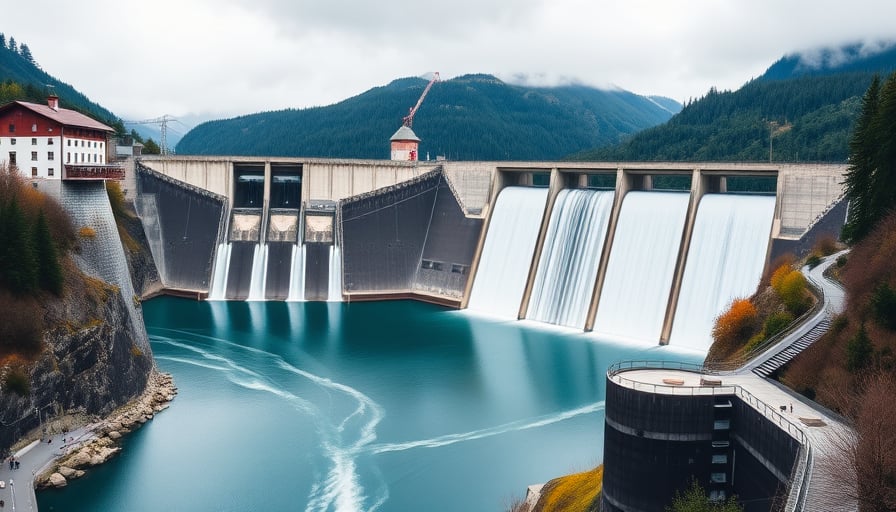Investigative Analysis of Verbund AG in the Context of Global Energy Market Volatility
1. Market Performance Overview
Verbund AG, the Austrian utility headquartered in Vienna, has shown a modest uptick in share price over the past week. The Vienna Stock Exchange’s ATX index, which incorporates Verbund, registered a marginal gain at the market open. Despite the broader volatility affecting peers in the sector, Verbund’s equity has not experienced significant swings. This steadiness reflects the company’s entrenched business model and its positioning within the regulated utilities space, which inherently dampens price volatility compared to more growth‑oriented peers.
2. Business Fundamentals
2.1 Integrated Generation, Transmission, and Distribution
Verbund’s vertically integrated structure—spanning hydroelectric, thermal, and wind generation, through to high‑voltage transmission and low‑voltage distribution—provides a natural hedge against market shocks. The diversification of generation assets dilutes exposure to any single fuel cycle, while the regulated transmission and distribution segments generate predictable, rate‑based revenue streams.
2.2 Asset Mix and Capacity
- Hydropower: Approximately 60 % of Verbund’s generation capacity derives from hydroelectric plants. While sensitive to hydrological conditions, Austria’s long‑term water balance and regulatory support for renewable energy maintain a relatively stable output profile.
- Wind and Solar: The company has invested heavily in onshore wind, contributing an additional 15 % of capacity. Recent regulatory incentives in the EU for offshore wind could present further expansion opportunities.
- Thermal: Residual thermal plants serve as peaking units and backup for intermittent renewables, ensuring grid stability.
2.3 Financial Health
- Price‑to‑Earnings Ratio (P/E): Verbund trades at a P/E slightly above the industry average, reflecting its stable dividend policy and low operational risk.
- Debt Profile: The company maintains a conservative debt‑to‑EBITDA ratio, consistent with regulatory expectations for utilities and providing ample room for refinancing in favorable interest environments.
- Dividend Yield: A consistent dividend payout of 4–5 % underscores management’s confidence in steady cash flow generation.
3. Regulatory Landscape
3.1 EU Renewable Energy Targets
The European Union’s 2030 Renewable Energy Directive mandates a 32 % share of renewables in total energy consumption. Verbund’s current hydro and wind mix positions it ahead of many peers, reducing exposure to future carbon pricing or renewable penalties.
3.2 National Energy Policy
Austria’s national grid and electricity policy prioritizes self‑sufficiency and cross‑border transmission capacity. Verbund benefits from preferential treatment in grid access and interconnector development, which enhances its market reach beyond Austria into Central Europe.
3.3 Cross‑Border Market Integration
Verbund participates in the European Power Exchange (EPEX SPOT), enabling real‑time trading of power across borders. The company’s robust transmission infrastructure positions it well to capitalize on price arbitrage opportunities arising from differential regional supply and demand.
4. Competitive Dynamics and Peer Benchmarking
| Company | Core Business | Recent Stock Movement | Key Drivers |
|---|---|---|---|
| Verbund AG | Integrated utilities | Stable, modest gains | Regulated, diversified assets |
| New Oriental Education & Technology Group | Education & tech | Daily limit reached | Strong pipeline & state reforms |
| Netease Technology | E‑commerce & semiconductors | Shares frozen | Regulatory freeze |
While New Oriental’s dramatic daily limit indicates a speculative rally driven by policy headlines, and Netease’s share freeze highlights regulatory risk, Verbund’s performance underscores the value of a mature, regulated utility model. However, this stability may also mask hidden risks:
- Technological Obsolescence: Emerging digital grid technologies (e.g., blockchain-based energy trading, AI‑optimized dispatch) could erode traditional utility margins if Verbund fails to invest adequately.
- Carbon Pricing: Despite current compliance, a future tightening of EU Emissions Trading System (ETS) could increase operating costs, especially for the remaining thermal plants.
- Hydrological Variability: Climate change could alter Austria’s hydrological cycles, impacting hydro generation reliability and necessitating costly capacity expansions.
5. Emerging Opportunities and Risks
5.1 Opportunities
- Grid Modernization Projects: Participation in Austria’s grid upgrade initiatives—particularly the expansion of high‑capacity interconnectors—could unlock new revenue streams from transmission services.
- Renewable Portfolio Expansion: Strategic acquisitions of offshore wind farms or solar projects in neighboring countries could diversify geographic risk and capture higher price premiums in those markets.
- Energy Storage Integration: While not a current focus, integrating battery storage with existing wind and hydro assets could enhance peak‑shaving capabilities, improving revenue per megawatt.
5.2 Risks
- Regulatory Shifts: Tightening of renewable curtailment policies or changes in cross‑border trade rules could compress margins.
- Supply Chain Constraints: Global semiconductor shortages, already affecting Netease’s semiconductor business, could impede modernization of Verbund’s control systems, inflating operating costs.
- Financial Market Conditions: A sustained rise in interest rates could raise the cost of debt refinancing, compressing profitability in a sector where capital expenditure cycles are long.
6. Conclusion
Verbund AG’s recent moderate stock performance reflects its entrenched position within a regulated, diversified utility framework. While its business fundamentals and regulatory footing provide resilience against market volatility, the company should remain vigilant about emerging technological trends and potential regulatory tightening. Investors looking for stability may find Verbund an attractive proposition, yet those seeking growth might overlook the subtle shifts in the European energy landscape that could either propel or erode the company’s long‑term value proposition.
